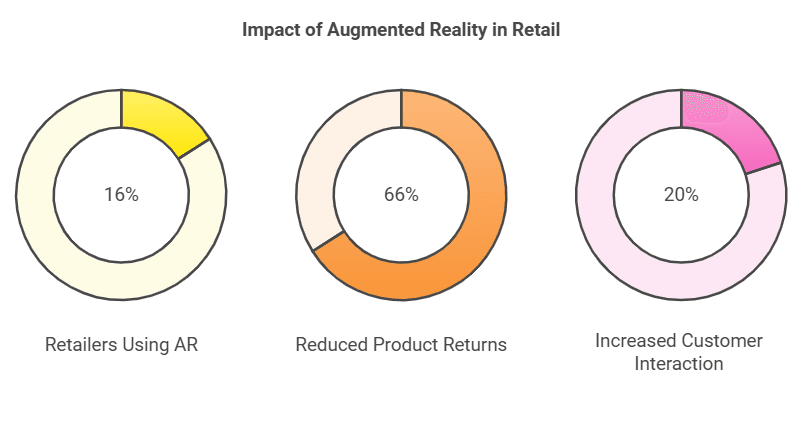Augmented Reality for Consumer Goods: Driving Sales with Interactive Packaging
In this modern world, consumer expectations are moving towards more engaging and customized shopping experiences. Augmented Reality (AR) is the leading of this transformation, reorganizing product packaging by enabling consumers to interact with products in innovative ways.
The Evolution of Product Packaging
Traditionally, product packaging served a functional purpose—protecting the product and providing essential information. However, with the rise of digital technology, packaging has evolved into a powerful marketing tool. Brands are now leveraging AR to create interactive experiences that captivate consumers and differentiate their products.
The Role of AR in Packaging Innovation
AR technology allows brands to integrate digital content into physical packaging, transforming it into an interactive platform. By scanning a QR code or using an app, consumers can unlock a variety of experiences, including:
Interactive Product Demonstrations: Consumers can see how a product works or its features through engaging animations with real-time immersive experiences
Customized Experiences: Brands can incorporate games or challenges that encourage consumer interaction and engagement.
Informative Content: AR can provide additional product information, such as usage instructions, nutritional facts, or sustainability efforts.
Engaging Consumers Through Interactive Experiences
Creative Storytelling
AR packaging enables brands to tell their stories in compelling ways. For instance, a beverage company might use AR to showcase the journey of its ingredients from farm to bottle. By scanning the packaging, consumers can view videos or animations that illustrate this narrative, fostering a deeper connection with the brand.
Enhancing Product Visualization
Consumers often want to visualize how a product fits into their lives before making a purchase. AR allows brands to create 3D models that consumers can interact with virtually. For example, a furniture brand could enable customers to see how a couch would look in their living room by overlaying a digital image onto their environment through their smartphone camera.
Statistical Insights on AR in Packaging
To understand the impact of AR on consumer goods packaging, consider these statistics:
Metric | Traditional Packaging | AR-Enhanced Packaging |
|---|---|---|
Average Engagement Time | 30 seconds | 2+ minutes |
Increase in Consumer Interaction | 1% | Up to 40% |
Brand Recall Rate | 10% | 70% |
Purchase Intent | 25% | 60% |
The Impact of AR on Consumer Behavior
Shifting Expectations
Modern consumers seek more than just products; they desire experiences that resonate with their values and lifestyles. AR packaging meets these expectations by providing unique interactions that enhance the overall shopping experience.
Building Brand Loyalty
By offering immersive experiences through AR, brands can foster stronger emotional connections with consumers. When customers engage with interactive packaging, they are more likely to develop loyalty toward the brand and make repeat purchases.
Overcoming Challenges in Implementing AR Packaging
While the benefits of AR are substantial, brands may face challenges when integrating this technology into their packaging strategies:
Cost of Development: Creating high-quality AR content can require significant investment.
Consumer Familiarity: Some consumers may be unfamiliar with using AR technology or hesitant to engage with it.
Technical Limitations: Ensuring compatibility across various devices is crucial for widespread adoption.
The global AR retail market was $2 billion in 2021 and will reach $61.3 billion by 2031.

Future Prospects for AR in Consumer Goods
As technology advances, the potential for AR in consumer goods packaging will continue to grow. Brands will increasingly explore innovative ways to leverage AR for enhanced engagement and storytelling:
Personalization at Scale: Future developments may enable brands to offer highly personalized experiences based on customized consumer data.
Sustainability Messaging: Brands can use AR to communicate their sustainability efforts effectively, educating consumers about recycling and eco-friendly practices.
Integration with E-commerce: As online shopping becomes more prevalent, integrating AR into e-commerce platforms will allow consumers to experience products virtually before purchasing.
Key Takeaways
Augmented Reality enhances product packaging by creating interactive experiences.
Successful case studies demonstrate increased engagement and brand recall.
The future of AR in consumer goods looks promising with advancements in personalization and sustainability messaging.
Conclusion
Augmented Reality is revolutionizing consumer goods packaging by transforming it into an interactive immersive platform that engages consumers in meaningful ways. By leveraging AR technology, brands can create memorable experiences that drive sales and promote loyalty. As this trend continues to evolve, embracing AR will be essential for brands looking to stay competitive in an increasingly digital marketplace.